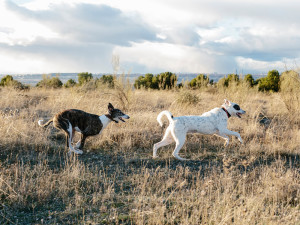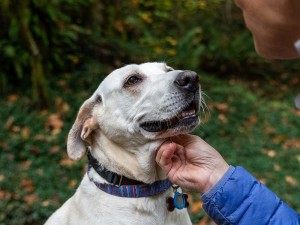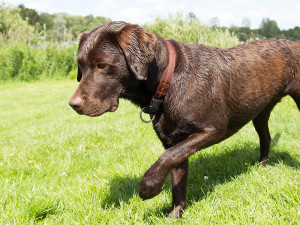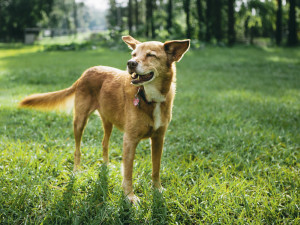Cancer in Dogs: A Primer on Canine Cancers
The word cancer can set alarm bells, turn down the volume by brushing up on cancer basics.

Share Article
A lump, a limp, a loss of appetite. The symptoms might have you asking, “Could this be cancer in my dog?” It’s a reasonable question, especially if your dog is middle-aged or older. According to the American Veterinary Medical Association (AVMA), one in four dogs will develop some form of cancer during their lifetimes. Cancer in dogs is a cellular glitch, an aberration, a system malfunction. And it sucks. Here’s what you need to know about cancer to help your dog through it.
What is cancer in dogs?
When cells within a dog’s body begin replicating uncontrollably, the growth is called a neoplasm (literally, new growth). Tumor, mass, and lump are how we describe the physical appearance of the neoplasm, but there’s more going on underneath.
A tumor can be either benign or malignant; only malignant tumors are considered cancers. That’s because benign tumors are known to be slow growers that do not spread throughout the dog’s body; they stick around the area they were formed. Malignant tumors? They’re unpredictable, they may invade or disturb the tissue around them, and they’ll spread across the dog’s body.
Cancer metastasizes, or spreads, when cells break away from the main tumor and enter the bloodstream or lymphatic system, which carries fluids around the body — basically, the cancer cells use these systems as highways to find new places to grow in the dog’s body. While, theoretically, all cancers can metastasize, not all cancer cells have the capacity on their own to do so or may lie dormant for months afterward, moving away from their source.

Cancer in dogs is categorized by the organs or systems they affect:
Carcinomas begin in the skin or tissues that line or cover the internal organs.
Sarcomas start in bone, cartilage, fat, muscle, blood vessels, or other connective or supportive tissue.
Leukemia begins in blood-forming tissue.
Lymphoma starts in the cells of the immune system.
So, they’re categorized based on how they grow and spread and by which organs they affect, but cancers in dogs are also classified by their grade and stage. A grade describes the appearance of the cancerous cells, while a stage describes a tumor’s size and how far it has spread from its origin on the dog’s body. Five of the most common cancers in dogs include mast cell tumorsopens in new tab, melanomaopens in new tab, lymphomaopens in new tab, osteosarcomaopens in new tab, and hemangiosarcomaopens in new tab.
What causes cancer in dogs?
Genetics may play a role. Purebred dogs are more likely to get cancer than mixed breeds. And there are certainly environmental stressors, like smoke and chemicals associated with almost every aspect of everyday life, that are known to cause cancer. Very few cancers have a single known cause or restrict themselves to a single age, gender, or breed type.
Dogs tend to develop most cancers later in their lives, but some breeds are known to be at higher risk for specific types of cancers, like osteosarcoma, often at a younger age. A breed’s genetic vulnerability isn’t the only factor, however. Individual dogs of any breed (or mix) have higher or lower sensitivities that may affect whether or not they develop cancer and how that cancer behaves.
Symptoms of Cancer in Dogs
If you notice any changes in your dog’s behavior or appearance, it’s time to visit your veterinarian. The symptoms below can be signs of cancer but may also indicate other diseases. Diagnosing severe health issues like cancer at an early stage means more treatment options are available, so if you notice that your dog has any unusual symptoms, contact your vet.
A growing or changing lump
Swollen lymph nodes
Abdominal swelling
Unexplained bleeding
Difficulty breathing, chewing, swallowing
Difficulty peeing or pooping
Persistent sores
Unusual swelling
Unusual other odor (or unexplained bad breath)
Dry cough
Lethargy
Vomiting
Diarrhea
Weight loss
Loss of appetite
Limping
Stiffness
Treatment for Cancer in Dogs
Diagnosing and treating canine cancer may involve a three-part team: the dog’s general-practice veterinarian, a veterinary oncologistopens in new tab, and, sometimes, a university teaching hospital. The initial diagnosis is most often made, or at least suggested, by the dog’s family veterinarian. Many vets will then refer their patients to a specialist to confirm the diagnosis and map out a treatment plan. Some of those specialists practice at university teaching hospitals, where the options and clinical capacities tend to be more extensive than at individual practices. Independent specialists may refer their patients to these facilities for treatment for the same reason.
How cancer in dogs is treated depends on where it is, what system(s) it affects, and how that particular cancer is known to respond to the various available options. Often, more than one approach is used. Barring the possibility of completely eliminating the cancer, veterinary specialists look for ways to put it into remission and/or help dogs and their owners cope with the challenges it creates.
Surgery
Surgery tops the list of the most common strategies to treat cancer in dogs. Removal of a malignant tumor with complete margins — encased in healthy tissue — offers a hopeful prognosis. Surgery is also used to improve a dog’s quality of life. For example, in the case of leg-based bone cancer (appendicular osteosarcoma), amputation of the affected limb can significantly reduce the dog’s pain. While it isn’t necessarily a cure, it helps a dog be more comfortable. Surgery may be followed by chemotherapy and/or radiation, or they may be used on their own.
Chemotherapy
Chemotherapy can be used to treat cancer in dogs. The drugs can be used to kill or slow the growth of cancer cells, and may be used to treat a cancer that doesn’t lend itself to surgical intervention or to reduce the size of a tumor before surgery is attempted. It’s also used to eliminate microscopic cancer cells before they can spread to other parts of the body. Unlike people, dogs rarely experience the side effects common to humans; 70 percent suffer few, if any, chemotherapy side effects.
Radiation Therapy
Radiation therapy destroys tumor cells’ DNA and is most often used with solid tumors — carcinomas or sarcomas. The goal is to provide long-term control by shrinking tumors and, possibly, a cure. Radiation is delivered as either external beam radiation therapy (also known as teletherapy) or stereotactic radiation therapy (SRT). SRT is particularly useful for brain and nasal cancers in dogs and can require only one to three treatments instead of the 15 to 20 needed for teletherapy. Other types of tumors, such as soft tissue sarcomas of the limbs, can be treated with repeated low doses of radiation, often resulting in a cure.
Cryosurgery
More accurately, it’s called cryotherapy since no cutting is involved — it uses liquid nitrogen to freeze small skin and subcutaneous (under the skin) tumors; it reportedly has a very high success rate. Swelling, reddening, and occasionally pain and lameness are among the possible side effects. At the upper end of the temperature scale, hyperthermia uses heat to damage cancer cells, and is almost always paired with other forms of therapy rather than used as a standalone. On its own, it has few side effects.
Immunotherapy
Many of these approaches have been used for decades, and their limits and therapeutic potential are well known. However, in recent years, more options are being tested in vet school laboratories and clinics across the country. Among them, immunotherapy — a way of weaponizing a dog’s immune system to take action against a cancer by recognizing the danger and destroying the cancer cells —has had encouraging results.
Experimental Cancer Treatments
An experimental vaccine made from a dog’s individual tumor has been used to treat bone cancer. In a study at the University of Missouri, the treatment plan for dogs with osteosarcoma was amputation of the affected limb followed by a vaccine made from the dog’s tumor. According to Jeffrey Bryan, DVM, MS, PhD, DACVIM/Oncology, “It’s the first time that dogs with osteosarcoma have experienced prolonged survival without receiving chemotherapy, which is really exciting.”
Another recently developed approach involves sequencing a tumor’s DNA to identify cancer-causing mutations and then using a customized drug therapy to attack the cancer cells; the treatment is delivered in pill form and can be administered at home.
And on the horizon, metabolomics, the large-scale study of very small molecules. At the Cornell College of Veterinary Medicine, a study of a type of lymphoma common to both people and dogs began in mid-2020opens in new tab. If successful, it may lead to the creation of precision medicine treatment plans.
Clinical Trials
Clinical trials are research studies aimed at evaluating treatments and intervention for cancer. They offer participants potential for a longer and better quality of life as well as an opportunity to help dogs who may develop cancer in the future. The AVMA maintains a searchable animal health studies databaseopens in new tab, and the Veterinary Cancer Society has an accessible databaseopens in new tab that lists both universities and other organizations running trials. The Comparative Oncology Trials Consortium maintains a list of trialsopens in new tab underway at vet schools across the nation. The nonprofit Morris Animal Foundationopens in new tab also provides a list of health studies that can be sorted by species and health issue.
Can cancer in dogs be cured?
The ideal and best-case scenario is to completely eliminate, or cure, the cancer affecting the dog. While this is sometimes possible, remission is usually a more realistic goal. Remission, or a regression of the cancer, can be partial — meaning that the disease’s burden on the body has been reduced by at least 50 percent — or complete — meaning that the cancer is undetectable by any standard screening test. Remission is rarely permanent, and dogs will usually experience a relapse at some point. If achieved, a second remission is likely to be shorter, since over time, cancer cells develop an immunity to the drugs used to fight them.
Cancers are wildly variable in their behaviors and responses to treatment; some, either because they’ve advanced too far or are too aggressive, are unlikely to go into remission. In that case, your veterinarian will treat your dog’s symptoms, including pain, with the goal of keeping them comfortable and maintaining their quality of life as long as possible.
Statistics can be useful when considering various treatment options, but they don’t predict how an individual dog, or the cancer they’re dealing with, will respond to whatever approach is taken. Some cancers can be successfully treated, some can be put into remission for a time, and some are just too aggressive to overcome.
Whatever cancer challenge your dog may face, keep in mind that there are things you can do to improve the quality of their life and, ideally, extend it. Ask questions, listen carefully to the answers and make decisions based on what best serves your dog. Your veterinarian is your partner in figuring out how to compassionately go forward.
Susan Tasaki
Freelance writer Susan Tasaki lives in the San Francisco Bay Area with her Husky, who wishes they both got out more.
Related articles
![Black and white dog lies on grass]()
Bone Regeneration: From Science Fiction to Fact
Veterinarians help suffering dogs by regrowing bones.
![Closeup of white lab mix dog being pet under the chin by pet parent]()
Can Dogs Get Breast Cancer?
Sadly, yes — one in four dogs will develop mammary tumors — but there's an easy way to prevent them.
![Brown Labrador lifting front leg]()
How to Get a Head Start on Your Pet’s Health
Spot lumps, limps, and lethargy early on.
![A dog outside with his mouth open coughing]()
Respiratory Illnesses in Dogs: 6 Serious Conditions Related to Coughing in Dogs
Vet advice on when you should be worried.






